(Click on photographs to see a larger version. Note: Some file sizes are quite large; not recommended for people using a dial-up connection.)
Here is a map of where we went. The numbers correspond to the days in the trip report.
Day 12, Friday 22 August, Gan Gan outstation
 After a late start, we flew south along the coast 120 km to Gan Gan outstation, a remote and traditional Dawangu aboriginal community by a river in tropical bushland. We think we are the first tour group to visit this community, but they do host pig and water buffalo hunting parties at another site removed from the village.
After a late start, we flew south along the coast 120 km to Gan Gan outstation, a remote and traditional Dawangu aboriginal community by a river in tropical bushland. We think we are the first tour group to visit this community, but they do host pig and water buffalo hunting parties at another site removed from the village.
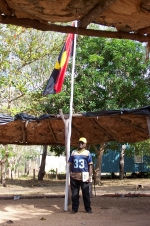 I’m not sure what we expected to find at the village, but ordinary tropical houses on stilts wasn’t it. The village was a cluster of houses around a large open area, with a school on one side and a meeting area on the other. Moveable pit toilets were situated behind each house. Large trees shaded the area. The village is located only a few hundred metres from the airstrip, but so well concealed that we didn’t spot it from the air.
I’m not sure what we expected to find at the village, but ordinary tropical houses on stilts wasn’t it. The village was a cluster of houses around a large open area, with a school on one side and a meeting area on the other. Moveable pit toilets were situated behind each house. Large trees shaded the area. The village is located only a few hundred metres from the airstrip, but so well concealed that we didn’t spot it from the air.
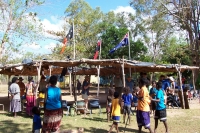 They have a telephone and several Toyota Land Cruisers, but no television (a deliberate choice), and plan to get a computer next year. The community is alcohol-free. We were quite taken by the blend of modern technology with ancient traditions, and the cleanliness of the town (in contrast to some other communities we’d been in, including Milingimbi).
They have a telephone and several Toyota Land Cruisers, but no television (a deliberate choice), and plan to get a computer next year. The community is alcohol-free. We were quite taken by the blend of modern technology with ancient traditions, and the cleanliness of the town (in contrast to some other communities we’d been in, including Milingimbi).
When we arrived, we were given a formal welcoming ceremony by the son of the village elder, Gawirrin Gumana, in the same meeting shelter where Gawirrin, one of Arnhem Land’s most prominent and respected elders, was honoured with his investiture as an Officer of the Order of Australia (AO) in May 2003. Gawirrin is a well known and respected painter of indigenous art internationally, and an ordained minister with the Uniting Church.
 We were then treated to morning tea, presented in a relatively European manner. (“It’s the Country Women’s Association!” exclaimed some of the women in our party in delight.) Our keen photographers soon won over the children by showing them immediate photos in the viewscreens of digital cameras. The younger children did not speak English, but the older ones were learning. (The early years of school are taught in the local language, to help ensure its survival, but in later school years the children are taught English, so they can participate in the wider community if they wish.)
We were then treated to morning tea, presented in a relatively European manner. (“It’s the Country Women’s Association!” exclaimed some of the women in our party in delight.) Our keen photographers soon won over the children by showing them immediate photos in the viewscreens of digital cameras. The younger children did not speak English, but the older ones were learning. (The early years of school are taught in the local language, to help ensure its survival, but in later school years the children are taught English, so they can participate in the wider community if they wish.)
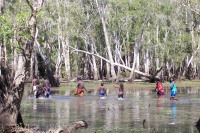 The whole group took us food gathering, showing us how to scare the crocodiles away and catch turtles and yabbies in the traditional way. The children caught 8 long neck turtles in the billabong. We drove around awhile looking for buffalo, and finally spotted one in the distance. After lunch we were taught more bushcraft, and then returned to the village for a traditional dancing demonstration by the children. Unfortunately we were running late, and absolutely had to get into the air by a certain time in order to get to our destination (an unlit airstrip) before dark, so we missed the dancing. I’m not sure who was more disappointed, us or the children — probably the children.
The whole group took us food gathering, showing us how to scare the crocodiles away and catch turtles and yabbies in the traditional way. The children caught 8 long neck turtles in the billabong. We drove around awhile looking for buffalo, and finally spotted one in the distance. After lunch we were taught more bushcraft, and then returned to the village for a traditional dancing demonstration by the children. Unfortunately we were running late, and absolutely had to get into the air by a certain time in order to get to our destination (an unlit airstrip) before dark, so we missed the dancing. I’m not sure who was more disappointed, us or the children — probably the children.

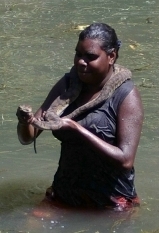 So, reluctantly on our way, we flew over Groote Eylandt in the Gulf of Carpentaria, then followed the coast of the Gulf south and inland to land just on sunset at Adels Grove. We’d camped here two years ago in our motorhome; this time we got to try the safari tents. The place was under new management, who had built a large new shop/ restaurant/ bar and expanded the accommodation. It was a very pleasant place to spend two nights, and encourages us to brave the bumpy road in again some year. Adels Grove, PMB 2, Mt Isa Qld 4825 phone (07) 4748 5502
So, reluctantly on our way, we flew over Groote Eylandt in the Gulf of Carpentaria, then followed the coast of the Gulf south and inland to land just on sunset at Adels Grove. We’d camped here two years ago in our motorhome; this time we got to try the safari tents. The place was under new management, who had built a large new shop/ restaurant/ bar and expanded the accommodation. It was a very pleasant place to spend two nights, and encourages us to brave the bumpy road in again some year. Adels Grove, PMB 2, Mt Isa Qld 4825 phone (07) 4748 5502
Day 13, Saturday 23 August, Riversleigh and Lawn Hill, Queensland
Adel’s Grove is located alongside Lawn Hill Creek, downstream from Lawn Hill Gorge. You can swim or canoe on the river, either here or at Lawn Hill.
 A tour bus took us to the World Heritage Listed Riversleigh Fossil Fields, about an hour’s drive away. We hadn’t gone there on our previous trip, so were glad to get the chance this time.
A tour bus took us to the World Heritage Listed Riversleigh Fossil Fields, about an hour’s drive away. We hadn’t gone there on our previous trip, so were glad to get the chance this time.
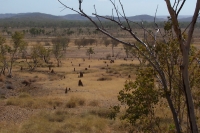 While there are hundreds of sites ranging in dates from 15,000 years to 25 million years, the D site is the only one open to the public. The public sites have been subject to theft of fossils, so many sites remain undisclosed.
While there are hundreds of sites ranging in dates from 15,000 years to 25 million years, the D site is the only one open to the public. The public sites have been subject to theft of fossils, so many sites remain undisclosed.
These fossils aren’t dinosaurs (as in some places further south), but Australian megafauna like giant emu-like birds and wombats.
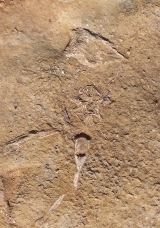 Some of the larger specimens were of Big Bird, a 3 metre 350kg flightless bird, typical of many existing in many areas around that period. While we quite understand the necessity for limiting access, it was rather disappointing to see so little (or maybe I’m just jaded by having seen lots of fossils over the years). The interpretive centre is quite good. I expect we’ll see more fossils at the museum in Mt Isa, when we finally get there.
Some of the larger specimens were of Big Bird, a 3 metre 350kg flightless bird, typical of many existing in many areas around that period. While we quite understand the necessity for limiting access, it was rather disappointing to see so little (or maybe I’m just jaded by having seen lots of fossils over the years). The interpretive centre is quite good. I expect we’ll see more fossils at the museum in Mt Isa, when we finally get there.
Riversleigh websites: Australian Museum Online, http://www.amonline.net.au/fossil_sites/riversleigh.htm
Australian Wildlife, http://www.australianwildlife.com.au/riversleigh.htm
Book: Australia’s Lost World: Prehistoric Animals of Riversleigh, by Michael Archer, Suzanne J. Hand, Henk Godthelp, David Attenborough, Indiana University Press, 2001, ISBN 0253339146, order from Amazon.com
 We continued a little further along the road and had morning tea on the Gregory River. Some very nice river scenery there, and lots of fish in the river. The causeway was so slippery I wasn’t willing to risk walking across it. Couldn’t be easy for vehicle tyres to retain a grip.
We continued a little further along the road and had morning tea on the Gregory River. Some very nice river scenery there, and lots of fish in the river. The causeway was so slippery I wasn’t willing to risk walking across it. Couldn’t be easy for vehicle tyres to retain a grip.
We bounced along the good but corrugated track back to Lawn Hill, where we had a quick lunch and headed to the gorge at 1 pm.
We divided, none too evenly, into two groups. Jean was reluctant to canoe, and went off with the hiking party over a track we had done a few years ago. Eric went with Thelma in a canoe, although he’d originally been going to canoe with Alf. Just as well he didn’t go with Alf; these 80 year olds make you look bad. Alf and Doreen were soon out of sight.
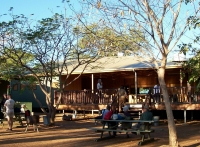
 It is only a few kilometres to Indarri Falls for swimming, and you have a great view of the gorge walls while paddling. The canoes got there first, so we were in the water having a swim and sitting under waterfalls by the time the hikers arrived.
It is only a few kilometres to Indarri Falls for swimming, and you have a great view of the gorge walls while paddling. The canoes got there first, so we were in the water having a swim and sitting under waterfalls by the time the hikers arrived.
The evening featured a lot of wine and much laughter over a fine dinner, as this would be out last night together as a group.
Day 14, Sunday 24 August, the long flight back to Sydney
Down eastern side of Barkley Tableland, refueling first at Mt Isa. The airport buildings were deserted and the terminal doors closed. We wandered around the tarmac for a while, trying various doors and gates, seeking an unlocked toilet. We finally found one at the Royal Flying Doctor building, and a sign on the wall made it apparent this was deliberate. Luckily the unattended fuel browser system at airports works very well indeed.
After takeoff from Mt Isa, Mark passed us some figures on the trip: 4333 nautical miles, average speed 160 knots, taking 27 hours in the air.
We landed at Blackall for refuelling. David wanted us to have a trophy photo of the group, with his tour banner streched between the planes, so we spent some time rearranging planes on the tarmac. Luckily the sun co-operated and the photos came out fine.
We made a rushed landing at Moree in a nasty crosswind, and took about five minutes to refuel. We headed straight off to Tamworth, where the wind was much higher, but at least not across the runway. The wind was also noticeable when landing at Bankstown in Sydney. We later learned from our taxi driver that gusty gale-force winds had downed trees and unroofed houses in the Sydney area that day; we could see the leaves and tree limbs all over the road. Good thing we hadn’t been trying to return earlier in the day!
Page last updated 6 October 2007.
